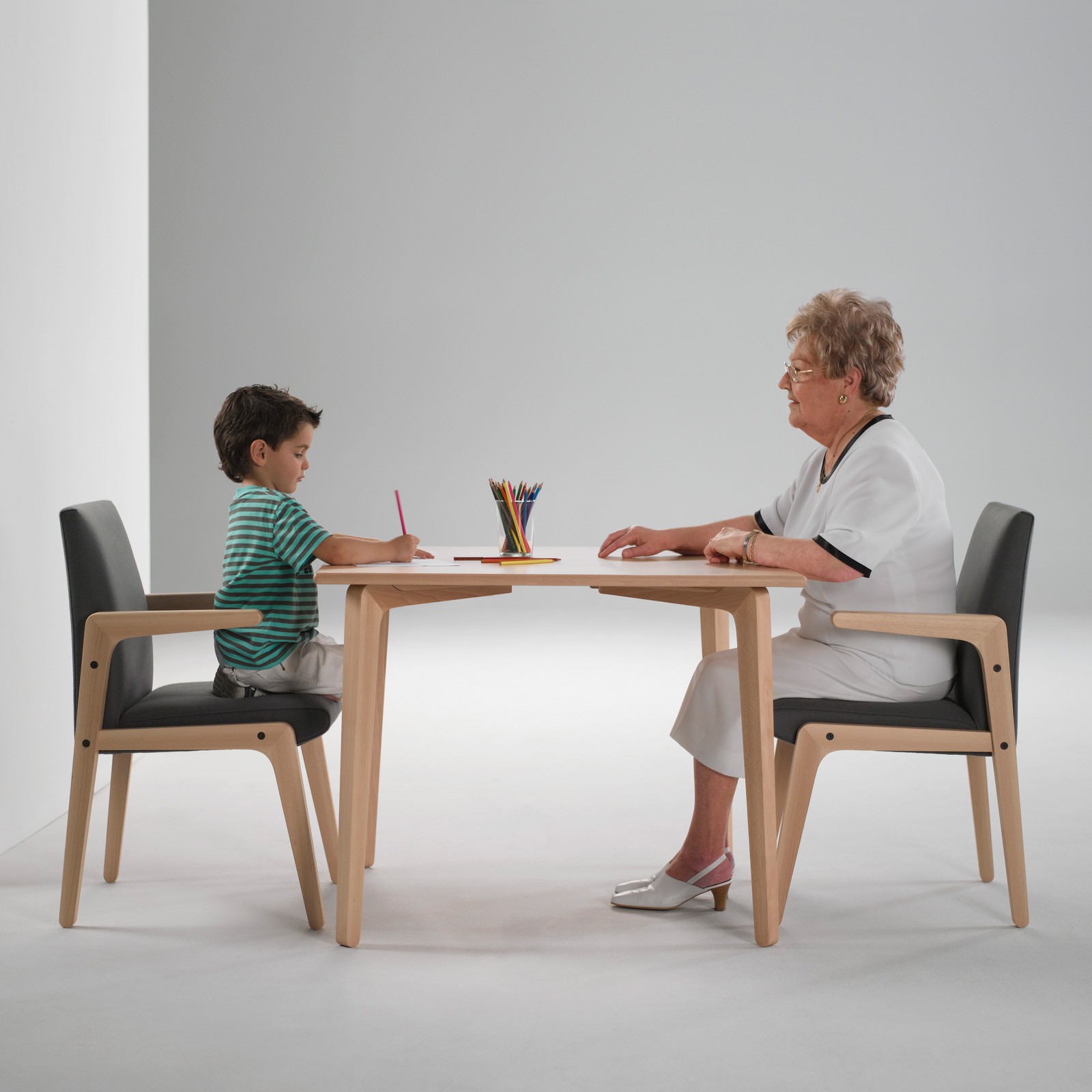
The desire to create more comfortable and welcoming environments in healthcare projects has seen a shift in the furniture designed and specified. But due to the nature of the environment and the variety of people using the furniture, the design and specification requirements need to go beyond comfort. Ergonomics, safety and durability are vital, and the choice of materials plays a role in hygiene and the visual environment.

Seating needs to ensure comfort for a wide range of users as people come in all shapes, sizes and abilities. Chairs should ideally be at 45-centimetre standard dining-seat height to make them easier to sit down in and stand up from, and one or two armrests will help this movement unaided.
Sancal’s Hera is a robust and contemporary armchair, with a seat height, upright backrest and arm height that provide ergonomic comfort for patients and carers in waiting rooms and patient rooms.
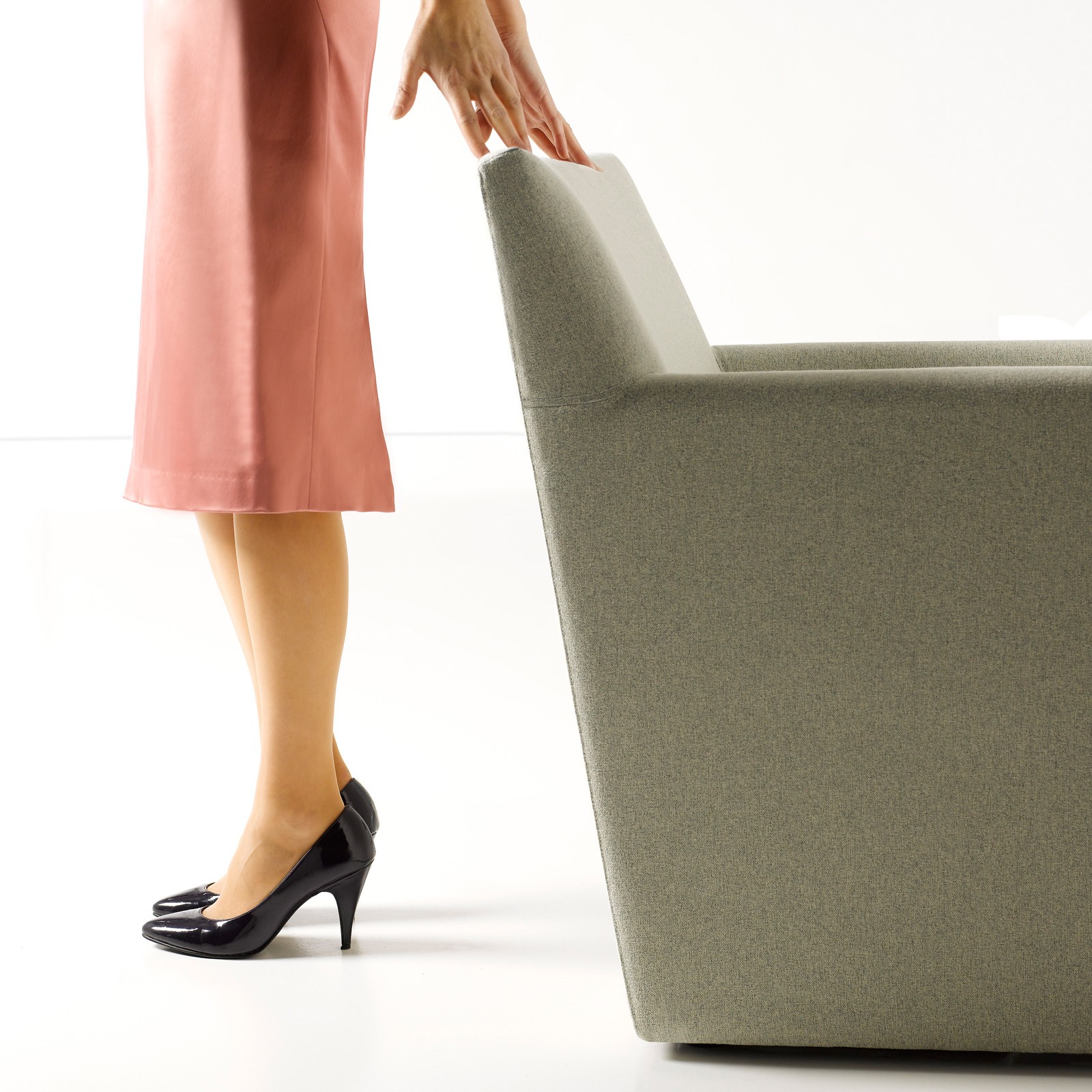 Proyec’s Boomerang
Proyec’s Boomerang is designed specifically for the needs of the elderly in care homes. The chairs are modern and timeless and promote ease of movement for sitting and support when getting up. A reclining back with good support facilitates correct posture and the space between the seat and arm rests allows for side access. Proyec also has a transfer chair for becoming comfortable – and stylish – when on the move. A notable project incorporating the Proyec Boomerang is the redesign of the Coastal Neurosurgery, NSW by Ricci Bloch Architecture + Interiors. Ricci selected this chair to place in the waiting area and rooms due to its natural materials, variety of warm colours and its ability to capture the comfort of a home environment, helping to soften the typical formality of clinics.
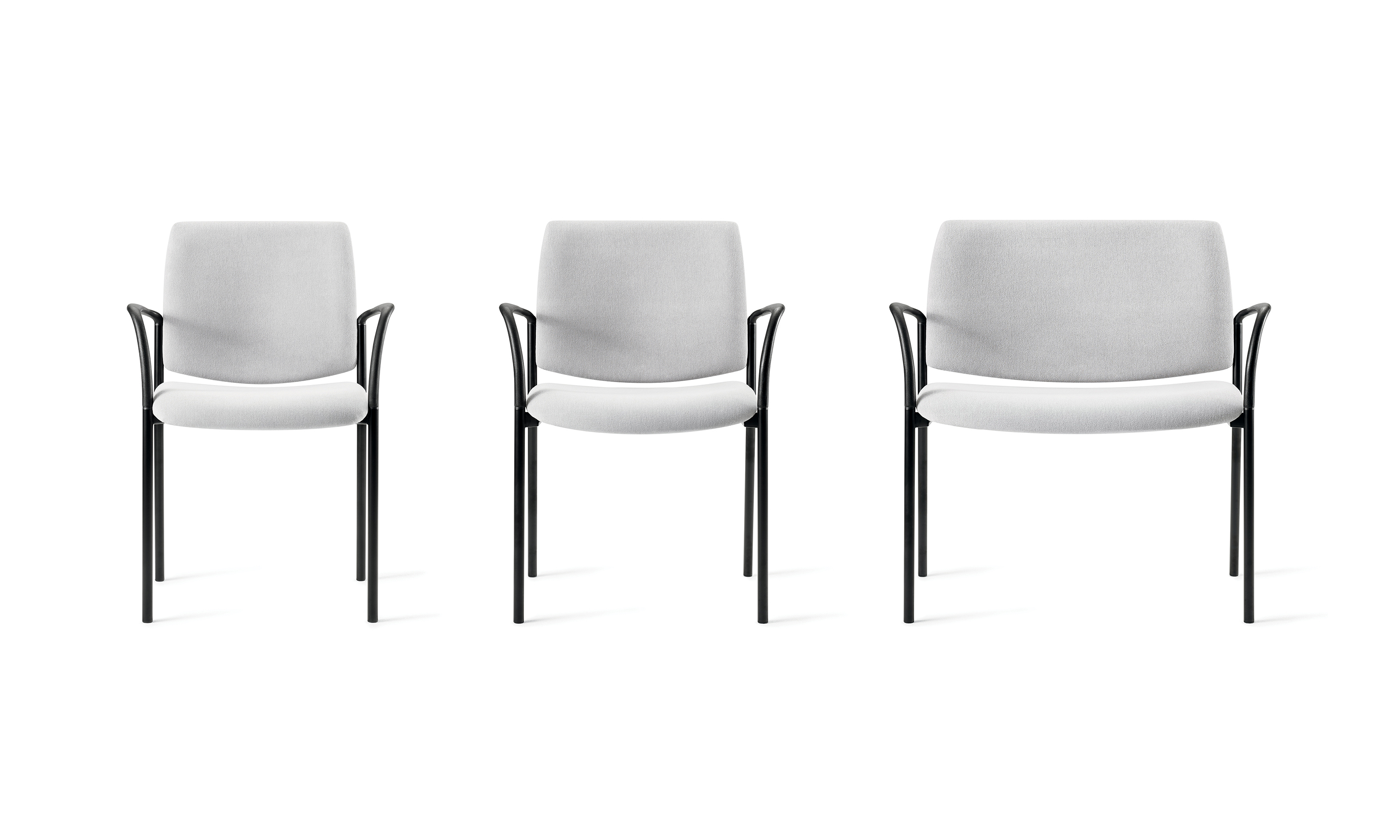
Wider and sturdier chairs are required for bariatric patients.
Source’s Cache collection is tested and certified by the Australasian Furnishing Research and Development Institute (AFRDI) to withstand a static load of 330 kilograms, with the widest version (660 millimetres) able to endure a static load up to 407 kilograms. Chairs have an upholstered seat and back and are available with or without arms.
Contemporary and streamlined design of chairs and tables reduces trips hazards, and is particularly important in aged-care facilities. Avoiding sharp corners and choosing furniture with legs and bases that don’t protrude, such as
Andreu World’s Reverse tables, will help to prevent falls and accidents. Andreu World’s Reverse table is low trip. Chairs should be light enough to pick up in environments where furniture can be moved, and glides on the bottom of chair frames can make them easier to slide on carpet.
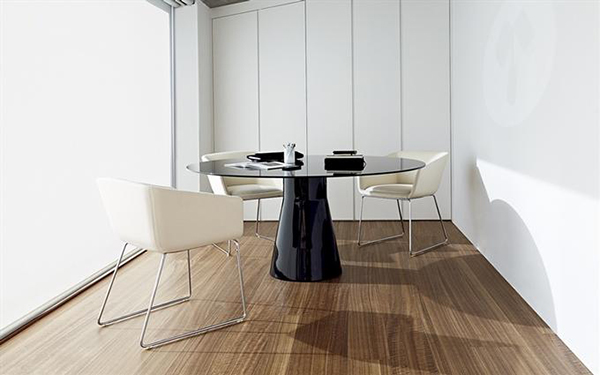
A more streamlined design also reduces the nooks and crannies that can collect and trap dust, dirt and crumbs, particularly for upholstered seats. Chairs with an open back – a gap between the seat and back – are easy to wipe down and keep clean. Solid surfaces, such as wood, aluminium and plastic, are also easier to clean and can show less wear and tear than upholstery.
Silver is used in some materials, such as powder coats and vinyl, because of its antibacterial properties, and manufacturers are utilising materials that comply with Green Star or
GECA certification to ensure products don’t have harmful contaminants.
ENEA’s Lottus collection has been certified for its low volatile organic compound (VOC) emission rate.
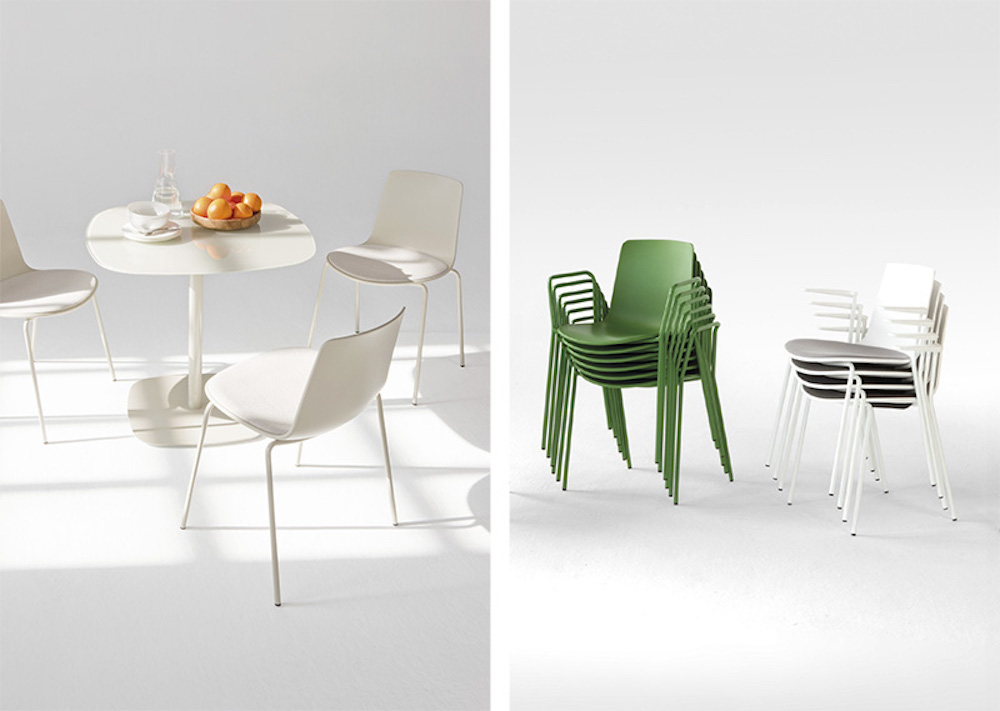
The Lottus collection is also designed to prevent the transmission of healthcare-associated infections spread through contact, contributing to a more hygienic environment and healthier people. The addition of the chemical agent Vibatan PP/M Bacteriostatic 02518 to the polypropylene shell enables Lottus chairs to actually inhibit the reproduction of bacteria.
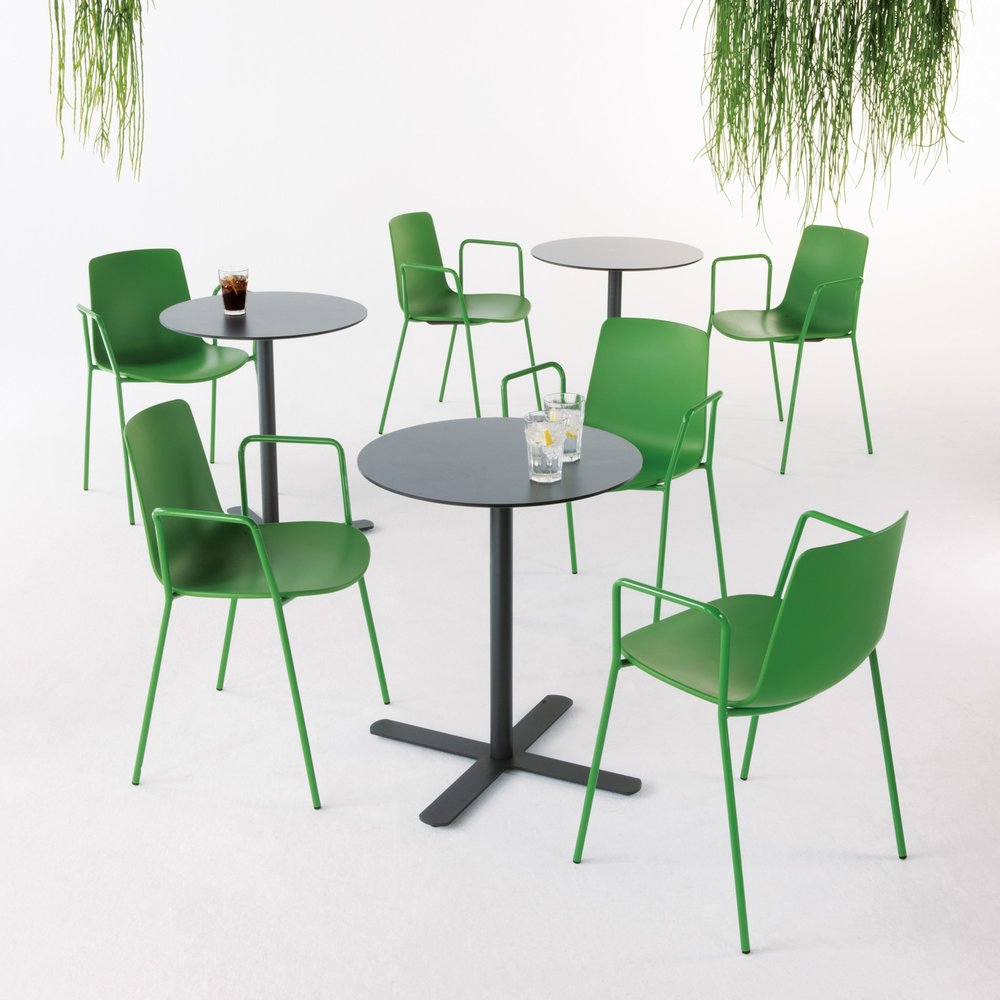
As residential design increasingly influences the choice of furniture in healthcare environments, there is also more vibrant colour and pattern being used for the upholstery. The colour palette can be used to provide visual relief, impact and wayfinding, as well as helping to set the mood, be it calm and quiet, or bright and joyful. Choosing fabric colours that visually stand out from the rest of the environment can be a smart choice in aged care environments so that chairs don’t become trip hazards when eyesight or coordination may be a problem. For upholstered chairs, a Martindale count of 100000 plus rubs will extend fabric longevity.
There are a lot of considerations when specifying furniture for healthcare settings. The KE-ZU team is well versed in these requirements and can help choose the right furniture for helping patients, carers and medical staff feel welcome, comfortable and safe.
Contact us to discuss your next Healthcare Project here The desire to create more comfortable and welcoming environments in healthcare projects has seen a shift in the furniture designed and specified. But due to the nature of the environment and the variety of people using the furniture, the design and specification requirements need to go beyond comfort. Ergonomics, safety and durability are vital, and the choice of materials plays a role in hygiene and the visual environment.
The desire to create more comfortable and welcoming environments in healthcare projects has seen a shift in the furniture designed and specified. But due to the nature of the environment and the variety of people using the furniture, the design and specification requirements need to go beyond comfort. Ergonomics, safety and durability are vital, and the choice of materials plays a role in hygiene and the visual environment.
 Seating needs to ensure comfort for a wide range of users as people come in all shapes, sizes and abilities. Chairs should ideally be at 45-centimetre standard dining-seat height to make them easier to sit down in and stand up from, and one or two armrests will help this movement unaided. Sancal’s Hera is a robust and contemporary armchair, with a seat height, upright backrest and arm height that provide ergonomic comfort for patients and carers in waiting rooms and patient rooms.
Seating needs to ensure comfort for a wide range of users as people come in all shapes, sizes and abilities. Chairs should ideally be at 45-centimetre standard dining-seat height to make them easier to sit down in and stand up from, and one or two armrests will help this movement unaided. Sancal’s Hera is a robust and contemporary armchair, with a seat height, upright backrest and arm height that provide ergonomic comfort for patients and carers in waiting rooms and patient rooms.
 Proyec’s Boomerang is designed specifically for the needs of the elderly in care homes. The chairs are modern and timeless and promote ease of movement for sitting and support when getting up. A reclining back with good support facilitates correct posture and the space between the seat and arm rests allows for side access. Proyec also has a transfer chair for becoming comfortable – and stylish – when on the move. A notable project incorporating the Proyec Boomerang is the redesign of the Coastal Neurosurgery, NSW by Ricci Bloch Architecture + Interiors. Ricci selected this chair to place in the waiting area and rooms due to its natural materials, variety of warm colours and its ability to capture the comfort of a home environment, helping to soften the typical formality of clinics.
Proyec’s Boomerang is designed specifically for the needs of the elderly in care homes. The chairs are modern and timeless and promote ease of movement for sitting and support when getting up. A reclining back with good support facilitates correct posture and the space between the seat and arm rests allows for side access. Proyec also has a transfer chair for becoming comfortable – and stylish – when on the move. A notable project incorporating the Proyec Boomerang is the redesign of the Coastal Neurosurgery, NSW by Ricci Bloch Architecture + Interiors. Ricci selected this chair to place in the waiting area and rooms due to its natural materials, variety of warm colours and its ability to capture the comfort of a home environment, helping to soften the typical formality of clinics.
 Wider and sturdier chairs are required for bariatric patients. Source’s Cache collection is tested and certified by the Australasian Furnishing Research and Development Institute (AFRDI) to withstand a static load of 330 kilograms, with the widest version (660 millimetres) able to endure a static load up to 407 kilograms. Chairs have an upholstered seat and back and are available with or without arms.
Contemporary and streamlined design of chairs and tables reduces trips hazards, and is particularly important in aged-care facilities. Avoiding sharp corners and choosing furniture with legs and bases that don’t protrude, such as Andreu World’s Reverse tables, will help to prevent falls and accidents. Andreu World’s Reverse table is low trip. Chairs should be light enough to pick up in environments where furniture can be moved, and glides on the bottom of chair frames can make them easier to slide on carpet.
Wider and sturdier chairs are required for bariatric patients. Source’s Cache collection is tested and certified by the Australasian Furnishing Research and Development Institute (AFRDI) to withstand a static load of 330 kilograms, with the widest version (660 millimetres) able to endure a static load up to 407 kilograms. Chairs have an upholstered seat and back and are available with or without arms.
Contemporary and streamlined design of chairs and tables reduces trips hazards, and is particularly important in aged-care facilities. Avoiding sharp corners and choosing furniture with legs and bases that don’t protrude, such as Andreu World’s Reverse tables, will help to prevent falls and accidents. Andreu World’s Reverse table is low trip. Chairs should be light enough to pick up in environments where furniture can be moved, and glides on the bottom of chair frames can make them easier to slide on carpet.
 A more streamlined design also reduces the nooks and crannies that can collect and trap dust, dirt and crumbs, particularly for upholstered seats. Chairs with an open back – a gap between the seat and back – are easy to wipe down and keep clean. Solid surfaces, such as wood, aluminium and plastic, are also easier to clean and can show less wear and tear than upholstery.
Silver is used in some materials, such as powder coats and vinyl, because of its antibacterial properties, and manufacturers are utilising materials that comply with Green Star or GECA certification to ensure products don’t have harmful contaminants. ENEA’s Lottus collection has been certified for its low volatile organic compound (VOC) emission rate.
A more streamlined design also reduces the nooks and crannies that can collect and trap dust, dirt and crumbs, particularly for upholstered seats. Chairs with an open back – a gap between the seat and back – are easy to wipe down and keep clean. Solid surfaces, such as wood, aluminium and plastic, are also easier to clean and can show less wear and tear than upholstery.
Silver is used in some materials, such as powder coats and vinyl, because of its antibacterial properties, and manufacturers are utilising materials that comply with Green Star or GECA certification to ensure products don’t have harmful contaminants. ENEA’s Lottus collection has been certified for its low volatile organic compound (VOC) emission rate.
 The Lottus collection is also designed to prevent the transmission of healthcare-associated infections spread through contact, contributing to a more hygienic environment and healthier people. The addition of the chemical agent Vibatan PP/M Bacteriostatic 02518 to the polypropylene shell enables Lottus chairs to actually inhibit the reproduction of bacteria.
The Lottus collection is also designed to prevent the transmission of healthcare-associated infections spread through contact, contributing to a more hygienic environment and healthier people. The addition of the chemical agent Vibatan PP/M Bacteriostatic 02518 to the polypropylene shell enables Lottus chairs to actually inhibit the reproduction of bacteria.
 As residential design increasingly influences the choice of furniture in healthcare environments, there is also more vibrant colour and pattern being used for the upholstery. The colour palette can be used to provide visual relief, impact and wayfinding, as well as helping to set the mood, be it calm and quiet, or bright and joyful. Choosing fabric colours that visually stand out from the rest of the environment can be a smart choice in aged care environments so that chairs don’t become trip hazards when eyesight or coordination may be a problem. For upholstered chairs, a Martindale count of 100000 plus rubs will extend fabric longevity.
There are a lot of considerations when specifying furniture for healthcare settings. The KE-ZU team is well versed in these requirements and can help choose the right furniture for helping patients, carers and medical staff feel welcome, comfortable and safe.
Contact us to discuss your next Healthcare Project here
As residential design increasingly influences the choice of furniture in healthcare environments, there is also more vibrant colour and pattern being used for the upholstery. The colour palette can be used to provide visual relief, impact and wayfinding, as well as helping to set the mood, be it calm and quiet, or bright and joyful. Choosing fabric colours that visually stand out from the rest of the environment can be a smart choice in aged care environments so that chairs don’t become trip hazards when eyesight or coordination may be a problem. For upholstered chairs, a Martindale count of 100000 plus rubs will extend fabric longevity.
There are a lot of considerations when specifying furniture for healthcare settings. The KE-ZU team is well versed in these requirements and can help choose the right furniture for helping patients, carers and medical staff feel welcome, comfortable and safe.
Contact us to discuss your next Healthcare Project here
